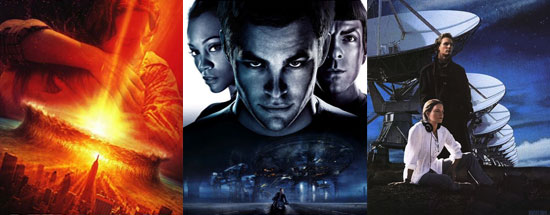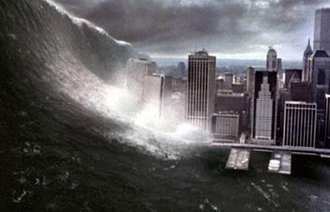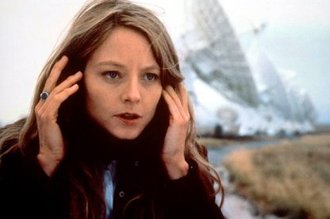Written by Phil Plait
 ”
”
Phil Plait is an astronomer and major sci-fi geek. He writes the Bad Astronomy Blog for Discover Magazine and is also the host of the Discovery Channel’s science show “Phil Plait’s Bad Universe.” You can follow him on Twitter at @BadAstronomer.
My old friends know better than to go see movies with me. Sure, I always yell at the screen when a movie spaceship make a “whooshing” noise when it flies past, but at least I don’t throw popcorn: At a prorated 10 cents or so per kernel, it’s simply not cost-effective. But at my best I still mutter under my breath, and sometimes even take notes for my blog.
Such is the life of an evil-hearted nerd scientist critic of science fiction movies.
Still, it’s not all bad. As rare as good stuff in movies can be, maybe it’s time to recognize it. I love a challenge, so let’s take a look: What movies got their science right?
(insert cricket noise)
No, seriously, a lot of movies really do. Well, some do. OK, a few do. Let’s start off with an easy one, like…
2001: A Space Odyssey
Ask any astronomer what movie comes closest to getting it all right, and they won’t hesitate: 2001. The obvious anachronism may make this one a teensy bit harder — Pan Am went out of business decades before the titular date, and the Space Station is hardly a giant spinning wheel in orbit — but a lot of the actual science is good.
There’s no sound in space, for example. Without air, there’s nothing to transmit the sound waves, and the movie shows space as deadly silent.
A classic scene has astronaut Frank Poole jogging around the circular centrifuge, and that’s on the money. Without gravity astronauts have all sorts of trouble, including serious health issues, such as muscle and permanent bone density loss. A spinning centrifuge would simulate gravity and mitigate a lot of those issues.
My favorite bit in the movie is that lack of stars in the exterior shots. If you were out in space and looking at a bright object like a sunlit spaceship, your eyes would adapt to that brightness level. Stars are pretty faint, and would be very hard to see!
And here’s one you might not have thought of (and I’ll risk geek blasphemy for saying it): Interplanetary travel is boring. A trip even to the moon takes three days. Mars is six months, and Jupiter would take years. Space is big and empty, so for 99 percent of the time there would be nothing to do. 2001 shows that beautifully by being boring. I mean, by showing that boredom!
Deep Impact
In 1998, two blockbusters came out about impacts: Armageddon, and Deep Impact. Armageddon was one of the worst movies in the history of humanity, if the not the universe in its entirety, so I’ll leave it alone (it does have one thing right: It’s about asteroids, and asteroids exist. Other than that …).
Deep Impact, on the other hand, got a lot right. The comet was discovered by an amateur astronomer (which was still common in the ’90s, though less now, with robotic surveys scanning the heavens much more efficiently). In the flick, a nuke only managed to split the comet into two pieces; in reality that’s likely to be what would happen to a fragile comet nucleus. The impact scene (damn! I forgot to say “spoiler alert!”) is wonderfully accurate, with the actual moment of collision and subsequent tsunami beautifully detailed and terrifying. Even the scenes filmed at the comet itself were good; the lack of gravity makes it impossible to land a ship, for example, so they tether themselves to it.
It was attention to that kind of detail that made my geeky inner (OK, outer) astronomer sing.
Contact
I have my suspicions that when we make first contact with aliens, it won’t be when they land their flying saucers on the White House lawn. That whole “space is big” thing really is a problem, and it’s a whole lot worse when the distances are measured in quadrillions of miles.
In Contact we find aliens because they beam an intense radio signal to us (though points are taken off for Jodie Foster’s character using headphones; computers are a wee bit better at detection than humans). That makes sense: A radio wave is easy to send, it travels at light speed, and you can encode a lot of information into it. So right off the bat, the movie has it right.
Not only that, but it also shows astronomers as, y’know, people, instead of cardboard caricatures, as usually done. Foster’s character actually — gasp — has a sex life!
Even the depiction of faster-than-light travel is consistent and well done. But none of this is surprising: The script was penned by Carl Sagan himself, an astronomer and brilliant writer. If you haven’t seen this flick, then stop reading my dorky stuff and go get it! Also, read the book Contact. If the last page doesn’t give you chills, you’re not a bona fide nerd.
Star Trek
Yes, the 2009 Trek reboot that pissed off a bazillion fans, who were appalled that suddenly their franchise could be made appealing to a broad audience. Still, despite all the debauching of science usually performed by Trek, there was one sequence made of win: Early on, when the Kelvin is attacked, we see explosions and running crewmen and lots of yelling and screaming. Suddenly, amidst the hullabaloo, a hull breach opens up and a crewmember is blown into space. We follow her out the hole, and suddenly all the noise is cut off.
Like 2001, this is a good depiction of space. Without air, there’s no noise. And the movie wins a second kudo from me because it was used dramatically: The sudden cessation of noise punctuates that death scene for the poor, unnamed crewperson, making it that much more chilling. Of course, that saves her from the awful science later in the movie as Vulcan collapses into a black hole (and don’t even get me started on “red matter”).
The Fountain
This wasn’t a blockbuster, but it was still a beautifully told tale of love, life, death and rebirth. I won’t spoil it for you, but I will say that this is, to my knowledge, the only movie that has ever used supernovae correctly.
When a massive star explodes at the end of its life, all the heavy elements it’s created (like iron, calcium and so on) are blown out into space, where they can merge with gas clouds. These clouds then collapse to form other stars, planets … and you. The iron in your blood and the calcium in your bones were literally forged in the hearts of ancient supernovae. When a star dies, it gives life to others … and that theme is used perfectly in the movie. It’s a metaphor for rebirth, but it’s also used in that way by the movie quite literally. Astrophysics as poetry! Awesome.
I could go on and on, but after this it’s a state of diminishing returns. I know there’s more good stuff out there on display in small doses in lots of movies. And I just bet you have more examples in your own movie collection. So tell me: What flicks do you hold up as a shining example of Science and Reality?
Bonus: No, it’s totally cool. See…






Textual content messaging has change into an integral part of our day-to-day lives. No one can deny the insurmountable amount of comfort it has allowed us when attending matters of each our personal and business affairs. The power to send quick messages on the go is what makes textual content messaging so attractive that most of us simply cannot dwell with out it. It has actually transcended from a mere luxurious to a necessity as evidenced by the heavy influx of cell telephones out there today. Among them, the Apple iPhone is probably the one which garnered essentially the most public adulation. It’s because the iPhone is the first cellphone that mixed the powers of both mobile phone and computer.
Biggest dork on YouTube. If you love Star Trek, you’ll wanna punch this kid in the face.